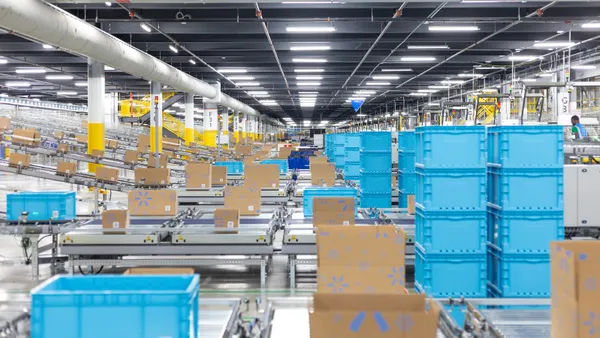Editor's note: This story outlines the latest data from the MHI Annual Industry Report on emerging technologies in the supply chain industry. If you're looking for the 2021 data, see our previous story.
If the past few years were the age of evolution in the supply chain, 2022 is the year of the supply chain revolution. That was the theme from MHI CEO John Paxton when presenting the findings from this year's survey of materials handling professionals and how likely they are to adopt 11 emerging technologies.
The survey is a keen insight into which technologies are having tangible impacts on how supply chain companies operate, and which tech, including often-lauded breakthroughs like blockchain and digital twins, companies value and are willing to invest in for the future.
11 technologies enter facilities, but adoption rates vary
% of survey respondents who said they are using the following technologies within facility operations
What was apparent at the survey unveiling in March was that executives are thinking not only about the technologies themselves, but the people that will build and operate them.
Like industries across the market, supply chains are suffering from labor constraints and a lack of trained workers. Executives said they hope new technologies can help both fill vacant job responsibilities and entice people to work with cutting edge tech.
“I think what we'll see over the next few years is hopefully an increase in the number of professional talent that are at the beginning of their career, really digging into the supply chain space, and they expect the technology,” said Terry Esper, Associate Professor of Logistics at The Ohio State University. “I mean, they've been educated for the last couple of years digitally. So they are truly expecting a more digital work experience.”
There's a lot in this year's report. We've highlighted three key stats for each technology explored in the report, on issues including the rate of adoption now and in the next five years, the potential for the technology to disrupt supply chains or create a competitive advantage, as well as barriers to adoption.
Inventory and network optimization tools
By the numbers
The percent of survey respondents who said …
87%
They expect to adopt network optimization tools in the next five years, up from 28% in use today.
43%
The technology supports ongoing improvements.
12%
They do not want to adapt their operations to adopt the technology.
Cloud computing and storage
By the numbers
The percent of survey respondents who said …
86%
They expect to adopt cloud computing in the next five years, up from 40% in use today.
31%
The technology has the potential to create a competitive advantage.
21%
Cloud computing lacks a clear business case to justify the investment.
Sensors and automatic identification
By the numbers
The percent of survey respondents who said …
84%
They plan to adopt sensors and automatic identification in the next five years, up from 31% in use today.
38%
The technology has the potential to create a competitive advantage.
18%
There is a lack of capital to make investments in the technology.
Predictive and prescriptive analytics
By the numbers
The percent of survey respondents who said …
82%
They plan to adopt predictive analytics in the next five years, up from 22% in use today.
41%
The technology has the potential to create a competitive advantage.
18%
There is a lack of adequate talent to implement/utilize the technology.
Internet of Things
By the numbers
The percent of survey respondents who said …
80%
They expect to adopt the technology in the next five years, up from 21% in use today.
34%
The technology has the potential to create a competitive advantage.
9%
There is a cultural aversion to risk regarding the technology.
Robotics and automation
By the numbers
The percent of survey respondents who said …
79%
They plan to adopt robotics and automation in the next five years, up from 28% in use today.
39%
The technology has the potential to create a competitive advantage.
18%
There is a lack of access to capital to make investments in the technology, among the highest for any technology.
Wearable and mobile technology
By the numbers
The percent of survey respondents who said …
75%
They expect to adopt cloud computing over the next five years. Forty percent of respondents say they use the technology today.
42%
The technology supports ongoing improvements.
20%
They are unwilling to invest in the technology due to economic uncertainty, the highest among any technology.
Artificial intelligence
By the numbers
The percent of survey respondents who said …
73%
They plan to adopt artificial intelligence in the next five years, up from 14% in use today.
36%
The technology has the potential to create a competitive advantage.
15%
There is a lack of adequate talent to implement/utilize the technology.
Blockchain and distributed ledger technologies
By the numbers
The percent of survey respondents who said …
68%
They plan to adopt blockchain in the next five years, up from 10% in use today.
27%
The technology has the potential to create a competitive advantage.
20%
They have a lack of understanding of the technological landscape, the highest among any technology.
3D printing (additive manufacturing)
By the numbers
The percent of survey respondents who said …
68%
They expect to adopt the technology in the next five years, up from 18% in use today.
32%
The technology will have little to no impact on the supply chain, the highest among any technology.
23%
The technology has the potential to create a competitive advantage, the lowest among any technology.
Autonomous vehicles and drones
By the numbers
The percent of survey respondents who said …
66%
They plan to adopt autonomous vehicles in the next five years, up from 16% in use today.
24%
There is a lack of a clear business case to justify the investment in the technology.
19%
The technology has little to no impact.













